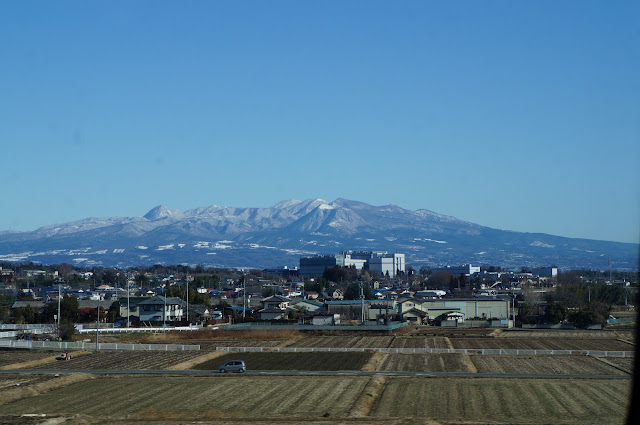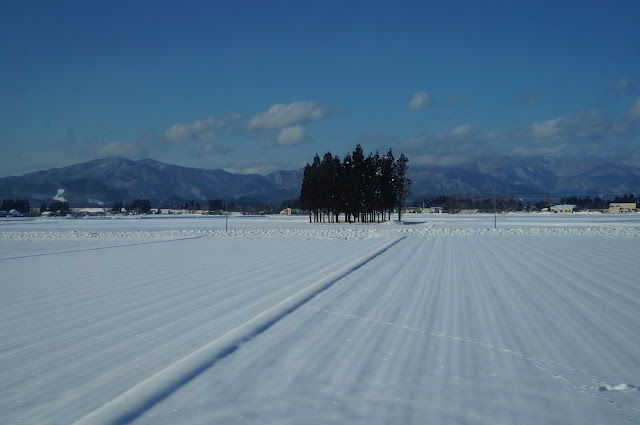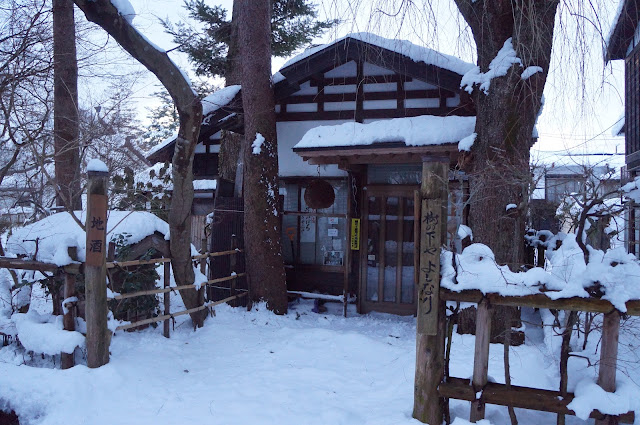It stands alone at the edge of the street, snow piled high against the sidewalk in front, concrete walls a spider's web of cracks. The sign atop reads Sharp, as in the ever troubled Japanese electronics manufacturer. At the window stands an ancient cathode ray television, petrol scooters and miscellaneous other items.
It could be a museum, but it isn't. The shop looks reasonably well cared for, but I would vouch that it hasn't seen any customers for many, many years.
This electronics store is like so many in small town Japan. It's difficult to imagine such a shop surviving long intact yet abandoned in Australia. Perhaps here it is like the offerings of fruit and other foods they leave for the dead. Perhaps the spirits shop here in a parallel world running to a different timeline.
Towns like Kakunodate and the railway lines that feed them are the reason I keep returning to Japan.
We had to push ourselves to reach the station in time to catch our Shinkansen. The Shinkansen line from Kanazawa to Tokyo has been in operation for less than two years and the trains are very comfortable and well equipped.
The scenery outside was snowy. From Kanazawa to Itoigawa we mostly followed the coast, mountains to our right, bright blue ocean in the distance to our left. Then we turned inland. In the gaps between tunnels there was some pretty mountain scenery. The heavy snowfalls around Nagano were quite apparent, the snow monkey park still closed today.
However as we moved further east the snow largely disappeared.
We left the train at Omiya, outside of Tokyo and transferred to the Tohoku Shinkansen line northwards. The red Komachi Shinkansen was narrower than the previous train, but was couple to a green Hayabusa Shinkansen. At Morioka these split, ours heading to Akita and the other to Shin-Aomori or Hakodate.
For a while the snow was minimal, but the further north we rode the heavier it became. The really beautiful bit was after we split. Here the Shinkansen travels slower, for it isn't really a high speed line anymore. Thick snow coated the Hilliard trees and there were amazing views of snow clad valleys traded with dark rivers.
Only a few of us left the train at Kakunodate. We had dressed more lightly for the train so it was fortunate that our hotel, the Folkloro was adjacent to the station.
A small hotel, its rooms have a sense of an dated, but clean, motel about them, but I like it all the same, a cosy and convenient escape from the thick snow outside.
All Alex wanted to do was play in the snow, but winter days are short and I desired to show them the town. I had made a very rushed trip here alone a few years ago and hoped to see more.
As we followed the street in clumps of snow fell from the trees and eaves of buildings. The odd shop, a garden products store, a bank, patisserie, hairdressers was open. Others like the Sharp building were indeterminate or derelict.
Around the centre of town there was more activity and even signs of tourism, with a large touch group of Koreans, the sound of Hong Kong accents and the chattering of school children heading home for the day.
Outside of cherry blossom season the main attraction of Kakunodate are the streets of old samurai buildings hidden behind black wooden walls along streets lined with huge cherry trees. Though bare of flowers and fruit they were adorned with white snow, a hazard to those beneath.
Not much was open, but it was pleasant just to stroll along. A local crafts shop sold beautiful wooden items, cherry blossoms carved into the bark exteriors. At the end of the first street we walked was a park covered with thick snow. Here we began a huge snowball fight.
Gosh it's fun to squeeze the soft powdery snow into a ball and chuck it!
Across from the park was a tiny sweets shop that sold melt in your mouth lozenges with peanut or sesame filling.
The sun was setting as we reached the river bank, cherry trees and snow drifts blocking the approach. We walked down the street, then turned in through another to reach the main samurai street. Sadly we were just too late to enter the one museum that seemed open, though we did have a walk around the grounds of another samurai house, stomping through deep snow.
Returning to the river, we crossed partway over the bridge to admire the beauty of the waterway and it's surrounds.
The streets back were decorated with colourful fairy lights giving the town a magical air. Near the Seven Eleven a large local souvenir shop was open, the owners convincing us with samples to purchase a number of crackers and other treats.
We were very hungry, but it wasn't even five thirty and none of the eateries appeared open. Alex was also tired and cold, feeling a little sick again, though thankfully the gastro made no more appearances again.
As we walked along the dark streets the odd little shop would still be open, a bright beacon leaking life into the ghostly black and white landscape. We stopped to buy a giant apple from a greengrocer, some slices of cake from the tiny Yamada patisserie.
Then the station appears, fairy lights and brown wooden buildings emerging out of the white snow.
We eat dinner at the hotel restaurant, a rare convenience, sampling local dishes like flat Inaniwa upon noodles, kiritanpo nabe and Hinaijidori chicken on rice. We adults enjoy it, but Alex, tired as he is, is less certain.
A combini (convenience store) at the station to the rescue, as they so often are, with some pot noodles for Alex. I don't mind. I love the idea of making do.
That's the thing about towns like Kakunodate. They may not be full of shopping malls and flash restaurants, but they usually have something to see and the oddest little places to eat. There is also this special magic about them, a sense that they are hovering on the boundary between the normal and the netherworld.
Alex and B may hunger for the bright lights and excitement of the cities, but I could stay here a lot longer.
It could be a museum, but it isn't. The shop looks reasonably well cared for, but I would vouch that it hasn't seen any customers for many, many years.
This electronics store is like so many in small town Japan. It's difficult to imagine such a shop surviving long intact yet abandoned in Australia. Perhaps here it is like the offerings of fruit and other foods they leave for the dead. Perhaps the spirits shop here in a parallel world running to a different timeline.
Towns like Kakunodate and the railway lines that feed them are the reason I keep returning to Japan.
We had to push ourselves to reach the station in time to catch our Shinkansen. The Shinkansen line from Kanazawa to Tokyo has been in operation for less than two years and the trains are very comfortable and well equipped.
The scenery outside was snowy. From Kanazawa to Itoigawa we mostly followed the coast, mountains to our right, bright blue ocean in the distance to our left. Then we turned inland. In the gaps between tunnels there was some pretty mountain scenery. The heavy snowfalls around Nagano were quite apparent, the snow monkey park still closed today.
However as we moved further east the snow largely disappeared.
We left the train at Omiya, outside of Tokyo and transferred to the Tohoku Shinkansen line northwards. The red Komachi Shinkansen was narrower than the previous train, but was couple to a green Hayabusa Shinkansen. At Morioka these split, ours heading to Akita and the other to Shin-Aomori or Hakodate.
For a while the snow was minimal, but the further north we rode the heavier it became. The really beautiful bit was after we split. Here the Shinkansen travels slower, for it isn't really a high speed line anymore. Thick snow coated the Hilliard trees and there were amazing views of snow clad valleys traded with dark rivers.
Only a few of us left the train at Kakunodate. We had dressed more lightly for the train so it was fortunate that our hotel, the Folkloro was adjacent to the station.
A small hotel, its rooms have a sense of an dated, but clean, motel about them, but I like it all the same, a cosy and convenient escape from the thick snow outside.
All Alex wanted to do was play in the snow, but winter days are short and I desired to show them the town. I had made a very rushed trip here alone a few years ago and hoped to see more.
As we followed the street in clumps of snow fell from the trees and eaves of buildings. The odd shop, a garden products store, a bank, patisserie, hairdressers was open. Others like the Sharp building were indeterminate or derelict.
Around the centre of town there was more activity and even signs of tourism, with a large touch group of Koreans, the sound of Hong Kong accents and the chattering of school children heading home for the day.
Outside of cherry blossom season the main attraction of Kakunodate are the streets of old samurai buildings hidden behind black wooden walls along streets lined with huge cherry trees. Though bare of flowers and fruit they were adorned with white snow, a hazard to those beneath.
Not much was open, but it was pleasant just to stroll along. A local crafts shop sold beautiful wooden items, cherry blossoms carved into the bark exteriors. At the end of the first street we walked was a park covered with thick snow. Here we began a huge snowball fight.
Gosh it's fun to squeeze the soft powdery snow into a ball and chuck it!
Across from the park was a tiny sweets shop that sold melt in your mouth lozenges with peanut or sesame filling.
The sun was setting as we reached the river bank, cherry trees and snow drifts blocking the approach. We walked down the street, then turned in through another to reach the main samurai street. Sadly we were just too late to enter the one museum that seemed open, though we did have a walk around the grounds of another samurai house, stomping through deep snow.
Returning to the river, we crossed partway over the bridge to admire the beauty of the waterway and it's surrounds.
The streets back were decorated with colourful fairy lights giving the town a magical air. Near the Seven Eleven a large local souvenir shop was open, the owners convincing us with samples to purchase a number of crackers and other treats.
We were very hungry, but it wasn't even five thirty and none of the eateries appeared open. Alex was also tired and cold, feeling a little sick again, though thankfully the gastro made no more appearances again.
As we walked along the dark streets the odd little shop would still be open, a bright beacon leaking life into the ghostly black and white landscape. We stopped to buy a giant apple from a greengrocer, some slices of cake from the tiny Yamada patisserie.
Then the station appears, fairy lights and brown wooden buildings emerging out of the white snow.
We eat dinner at the hotel restaurant, a rare convenience, sampling local dishes like flat Inaniwa upon noodles, kiritanpo nabe and Hinaijidori chicken on rice. We adults enjoy it, but Alex, tired as he is, is less certain.
A combini (convenience store) at the station to the rescue, as they so often are, with some pot noodles for Alex. I don't mind. I love the idea of making do.
That's the thing about towns like Kakunodate. They may not be full of shopping malls and flash restaurants, but they usually have something to see and the oddest little places to eat. There is also this special magic about them, a sense that they are hovering on the boundary between the normal and the netherworld.
Alex and B may hunger for the bright lights and excitement of the cities, but I could stay here a lot longer.




































































Comments